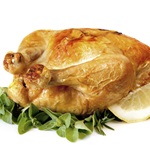Choosing Poultry Debate
Poultry holds the middle ground in the eating-of-animal-flesh debate. It’s better for you than beef, but not as good for you as seafood.
Compared with beef, poultry is:
• slightly lower in calories, depending on the cut
• lower in fat, depending on the cut
• lower in vitamin B-12
• lower in zinc and iron (except for turkey breasts)
• higher in essential fatty acids
• easier to digest
• It’s easier to lower the fat level in chicken or turkey than in beef.
The most important thing you can do to get less saturated fat from your bird is to remove the skin, since most of the fat is found here rather than marbled through the bird’s muscle. Removing the skin from the poultry reduces the calories by at least 20 percent and the fat by 40-50 percent, but it does not significantly change cholesterol levels.
• Choose white meat over dark meat if avoiding fat is your goal. Compared with white meat, dark meat is approximately 25 percent higher in calories and over twice as high in fat. Dark meat is also slightly higher in cholesterol. White chicken meat is nearly twice as high in niacin. Dark chicken meat offers two-to-three times as much zinc and iron as white meat.
• Turkey offers certain advantages over chicken. It is around 20 percent lower in calories and 75 percent lower in fat. Turkey is rich in niacin, with 7 milligrams in a 31/2 ounce serving (33 percent of RDA), though this is half the amount in chicken. Turkey contains more zinc and iron and slightly more vitamin E. Three-and-half ounces of turkey breast contain a paltry one gram of fat. Ground turkey patties are a healthy alternative to beef burgers. (Read the label on the ground turkey package. Some ground turkey contains a lot of dark meat and a great deal of fat. Choose your cut of turkey breast and have the butcher grind it for you.)
• Poultry safety. One problem with poultry is how chickens are raised and fed. At least in theory, free-roaming chickens (listed on menus and labels as “free-range” chickens) produce healthier eggs, at least if they are depending on the chicken feed. If, as studies have shown, free-range chickens produce healthier eggs, perhaps we could assume the meat of free-range chickens is also more nutritious. Common sense would tell us that a healthier chicken who is outdoors in the fresh air and sunshine would be better to eat than one that has spent its short, sad life penned up in a cage unable to roam and search for natural food.
Dr. Sears, or Dr. Bill as his “little patients” call him, has been advising busy parents on how to raise healthier families for over 40 years. He received his medical training at Harvard Medical School’s Children’s Hospital in Boston and The Hospital for Sick Children in Toronto, the world’s largest children’s hospital, where he was associate ward chief of the newborn intensive care unit before serving as the chief of pediatrics at Toronto Western Hospital, a teaching hospital of the University of Toronto. He has served as a professor of pediatrics at the University of Toronto, University of South Carolina, University of Southern California School of Medicine, and University of California: Irvine. As a father of 8 children, he coached Little League sports for 20 years, and together with his wife Martha has written more than 40 best-selling books and countless articles on nutrition, parenting, and healthy aging. He serves as a health consultant for magazines, TV, radio and other media, and his AskDrSears.com website is one of the most popular health and parenting sites. Dr. Sears has appeared on over 100 television programs, including 20/20, Good Morning America, Oprah, Today, The View, and Dr. Phil, and was featured on the cover of TIME Magazine in May 2012. He is noted for his science-made-simple-and-fun approach to family health.

